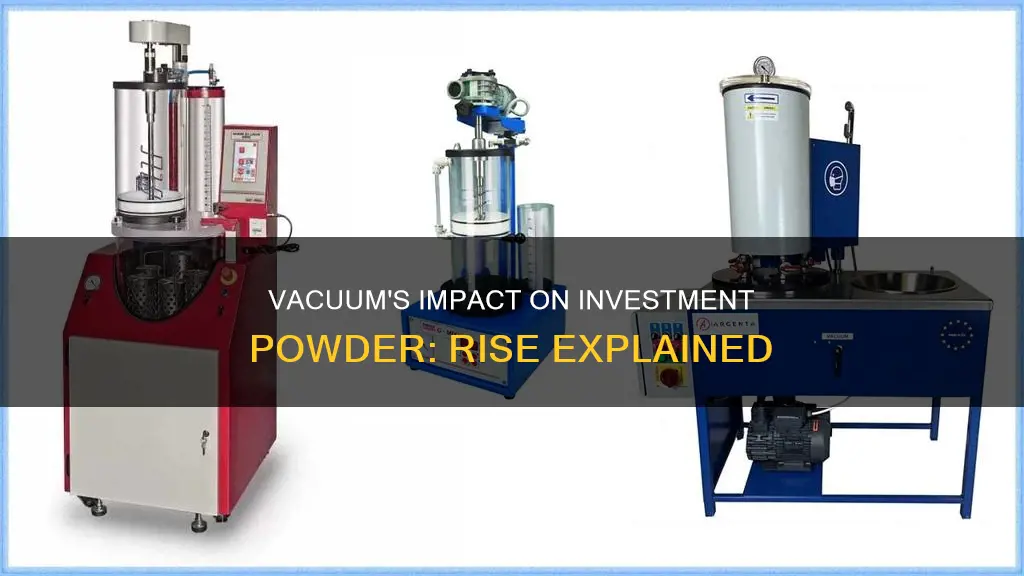
The process of investment casting is widely used in the production of both commercial and unique art metal objects. It involves creating a mould by pouring investment powder mixed with water into a flask. This mould is then used to cast the desired metal object. One issue that can occur during this process is an investment blowout, where the bottom of the investment shatters and drops out of the flask. This can be caused by a variety of factors such as incorrect powder-to-water ratio, overfilling the flask, rapid temperature changes, or improper handling. To prevent this, it is important to follow manufacturer instructions, measure and monitor the investment carefully, and ensure proper vacuum pressure.
What You'll Learn
- The importance of measuring the height of trees before investing
- The impact of using a debubblizer to reduce surface tension
- How to properly position the tree in the flask for optimal investment strength?
- The consequences of incorrect powder-to-water ratios
- The role of vacuuming in removing trapped and suspended air

The importance of measuring the height of trees before investing
- Optimal Tree Height: By measuring the height of the trees, you can ensure they are the correct height relative to the fill level of the flask. For smaller trees, the maximum height should be 0.5 inches shorter than the fill level, while for larger trees with more metal, the maximum height should be 0.75 inches shorter. This ensures the investment doesn't overflow and creates the necessary space for the investment to rise under vacuum.
- Space Allowance: Proper measurement of tree height allows for adequate spacing between the top of the investment and the top of the flask. When using benchtop vacuum casting with a solid flask, leaving a 0.125-inch gap is crucial. This space is essential for the expansion of the investment during the vacuuming process, preventing it from overflowing or cracking.
- Consistency and Precision: Measuring the height of trees before investing ensures consistency and precision in your casting process. Each tree should conform to specific height standards, reducing the likelihood of errors or miscalculations that could lead to investment blowout or other issues.
- Safety and Quality: Ultimately, measuring tree height contributes to the overall safety and quality of your investment casting process. By following this practice, you reduce the risk of accidents, ensure the integrity of your casts, and enhance the final product's quality.
- Flexibility and Customization: Understanding the height of your trees allows for flexibility in your casting process. Depending on the height of the trees, you can adjust the length of the tree accordingly when using perforated flasks cast in a vacuum chamber or with centrifugal casting. This customization ensures the process is tailored to your specific needs.
In conclusion, measuring the height of trees before investing is a critical step that cannot be overlooked. It ensures the success of your investment casting, prevents common issues like blowout, and guarantees the safety and quality of your final product. By following this practice, you set yourself up for a seamless and efficient casting experience.
SVB's Bad Investments: Where Did It All Go Wrong?
You may want to see also

The impact of using a debubblizer to reduce surface tension
A debubblizer is a surface tension-reducing agent or chemical compound used in industrial processes to minimize air bubbles when casting a mold or impression. It is also used in dentistry, where it is known as a surfactant or wetting agent.
Firstly, it allows for better flow of investment powder. By reducing surface tension, the debubblizer enables the investment to flow more uniformly and smoothly to all portions of the wax pattern. This ensures that the investment fills the flask evenly and reduces the likelihood of air bubbles forming.
Secondly, it helps to prevent air bubbles from clinging to the surface of the mold. Air bubbles can cause nodules on the casting, affecting the quality of the final product. By reducing surface tension, the debubblizer makes it more difficult for air bubbles to form and attach to the surface.
Thirdly, it improves the mixing process. The reduction of surface tension allows for better mixing of the investment powder and fluid, ensuring a more homogeneous slurry. This is crucial in achieving the desired strength and quality of the investment.
Additionally, the use of a debubblizer can help eliminate air bubbles that may be trapped or suspended in the investment after the vacuuming process. This is important as trapped air can expand and rise during vacuuming, causing the investment to rise and boil.
Overall, the use of a debubblizer to reduce surface tension can significantly improve the quality of the casting process by reducing air bubbles, improving flow, and enhancing the mixing process. This leads to a smoother, more uniform final product with fewer defects.
Indie-Gogo Campaigning: Strategies for Investment Success
You may want to see also

How to properly position the tree in the flask for optimal investment strength
To properly position the tree in the flask for optimal investment strength, it is important to follow these steps:
Firstly, measure the height of the tree before investing. The maximum height of the tree should be between 0.5 inches and 0.75 inches shorter than the fill level of the flask, depending on the size of the tree. This measurement is crucial to prevent investment blowout. Additionally, when using a benchtop vacuum casting with a solid flask, maintain a gap of 0.125 inches between the top of the investment and the flask's top. On the other hand, if you are using perforated flasks cast in a vacuum chamber or centrifugal casting, you can fill the flasks completely and adjust the tree height accordingly.
Secondly, ensure there is ample space between the tree and the sidewall of the flask. Specifically, there should be a minimum distance of 0.25 inches (6 mm) between the outermost part of the pattern and the flask's sidewall. This spacing is significant as it helps calculate the time available before the flask cools down and affects the casting process.
By following these guidelines, you can properly position the tree in the flask, contributing to optimal investment strength and successful casting outcomes.
Portfolio Management: Broker's Investing Strategy for You?
You may want to see also

The consequences of incorrect powder-to-water ratios
An incorrect powder-to-water ratio can have several negative consequences, especially when using vacuum investing machines. If there is too much water in the mixture, it can cause what is known as "investment blowout". This occurs when there is too much air trapped in the mixture, causing it to expand and rise during vacuuming, which can lead to cracking or chipping. To prevent this, it is important to follow the manufacturer's instructions for the correct powder-to-water ratio and ensure that the work time of the investment is fully used.
Incorrect powder-to-water ratios can also lead to problems with the final product. For example, if there is too much water, it can result in under-dilution or over-concentration of the formula, which can cause short-term health issues such as hypernatremic dehydration, gastroenteritis, and other digestive problems. On the other hand, if there is too little water, it can lead to over-dilution, resulting in long-term health issues such as nutrient deficiencies and even death.
In addition, incorrect powder-to-water ratios can affect the setting time of the investment. If there is too much water, the slurry may start to set while still under vacuum, reducing the work time available. Conversely, if there is too little water, the setting time may be prolonged, affecting the overall production time.
It is also important to note that the powder-to-water ratio can impact the strength and durability of the investment. Too much water can lead to higher porosity, making the investment more fragile and susceptible to cracking or chipping. On the other hand, too little water can result in a dense and brittle investment that is more prone to shattering.
Furthermore, incorrect powder-to-water ratios can affect the surface texture and finish of the final product. An incorrect ratio can lead to a chalky or dusty appearance, affecting the aesthetic quality of the investment.
To avoid these issues, it is crucial to carefully measure and monitor the powder-to-water ratio, following the manufacturer's instructions and recommendations. This will ensure the desired consistency and setting characteristics, as well as help prevent health and safety risks associated with incorrect ratios.
Building a Dividend Portfolio: Investing $12,000 with Schwab
You may want to see also

The role of vacuuming in removing trapped and suspended air
The process of vacuuming the investment involves placing it under a vacuum to remove air from the mixture. This step is essential as it helps to ensure the integrity and quality of the final casting. During vacuuming, the investment may rise and boil as the trapped air expands and escapes. This step should be carefully monitored, as over-vacuuming can lead to the formation of small spherical nodules on the casting.
To achieve optimal results, it is recommended to follow the manufacturer's instructions for the specific investment product being used. The amount of water used, the mixing time, and the viscosity of the investment are all factors that can influence the effectiveness of vacuuming. Maintaining the correct powder-to-water ratio is critical, as too much water can lead to problems such as flashing or finning.
Additionally, the timing of the vacuuming process is crucial. The investment should be vacuumed within the recommended work time, which is typically around 8 to 9 minutes. If the investment is poured too early or too late in the cycle, it can result in defects such as large cavities or spherical nodules.
In conclusion, vacuuming plays a vital role in removing trapped and suspended air from the investment powder. By eliminating air pockets and bubbles, vacuuming helps to ensure the strength and quality of the final casting. Proper timing, adequate mixing, and maintaining the correct powder-to-water ratio are all essential factors in achieving successful results.
Foreign Direct Investment: India's Investment Opportunities and Strategies
You may want to see also
Frequently asked questions
The ideal powder-to-water ratio is critical to the success of the investment process. The ratio should be carefully measured by weight, with less water resulting in a shorter setting time and a thicker mix.
The work time for investment powder is typically around 8 minutes. It is important to ensure that the entire work time is used to prevent the slurry from setting prematurely.
The work time can be influenced by the temperature of the water and the investment powder. Higher temperatures will result in a shorter work time. Additionally, the powder-to-water ratio can also impact the work time, with more water extending the time.
Using too much water in the investment powder mixture can lead to problems such as flashing or finning, and it can also affect the physical strength of the investment, making it more fragile.
To prevent investment blowout, it is important to measure the height of the trees before investing. The maximum tree height should be slightly shorter than the fill level of the flask, and a gap should be left between the top of the investment and the flask when using a benchtop vacuum casting setup.







